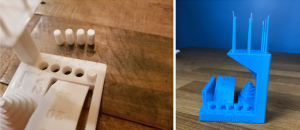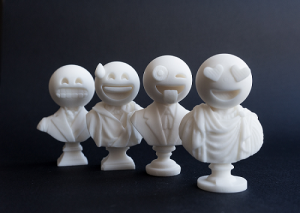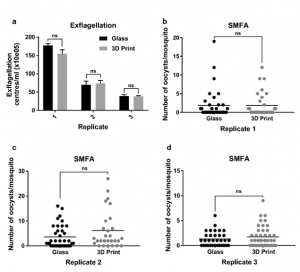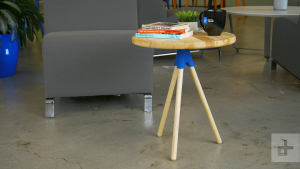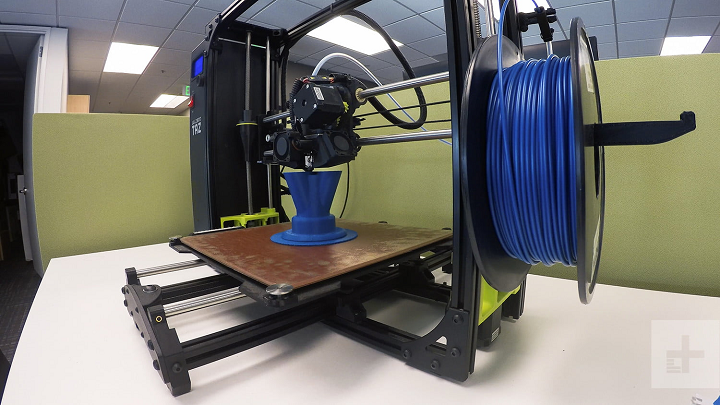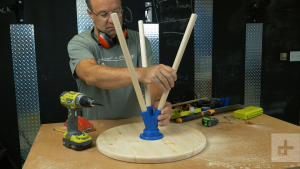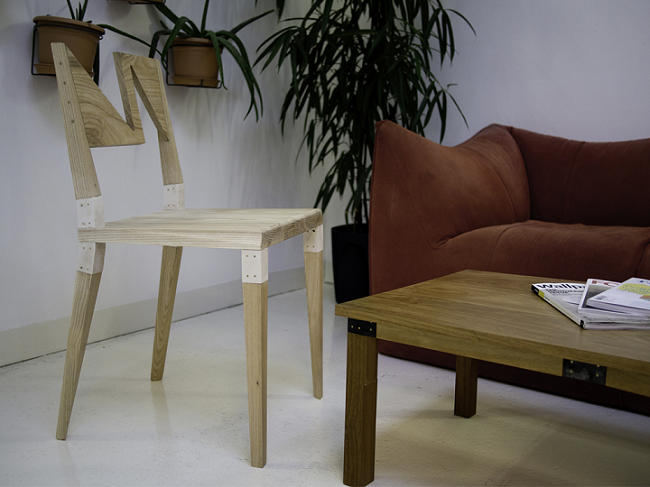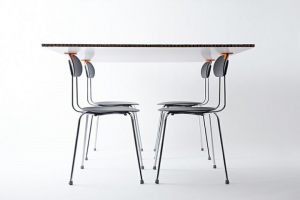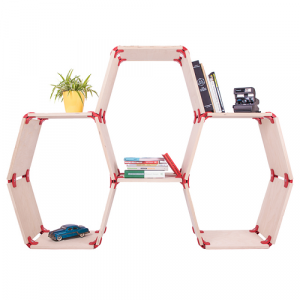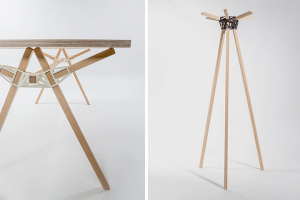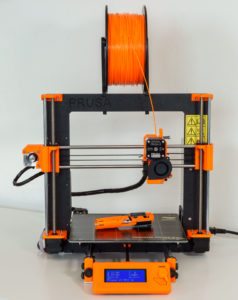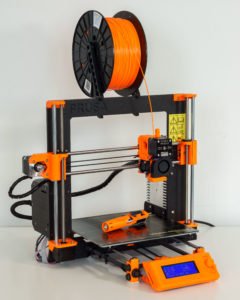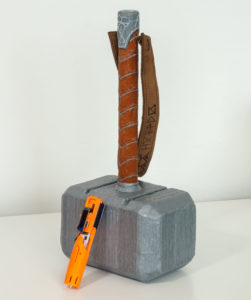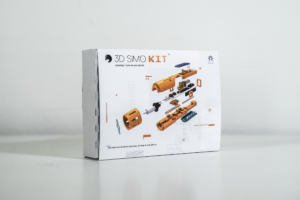3D Printing News Briefs: September 14, 2018
We’re bringing you the latest 3D printing business news in today’s 3D Printing News Briefs, plus a little 3D printed art to round things out. FATHOM is partnering with SOLIDWORKS software reseller GoEngineer, while L’Oréal is working with INITIAL, a Prodways Group company. Kickstarter and Autodesk are releasing a new open source 3D printing test, and 3D LifePrints has renewed its collaboration with the Alder Hey Children’s Hospital. Fargo 3D Printing has formed a new spin-off business, a metal 3D printed parts bureau has purchased an EBAM system from Sciaky, and 3D Systems’ SLA technology is being used to deliver customized dental solutions. Finally, we take a look at some fun and creative 3D printed artwork.
FATHOM and GoEngineer Announce Strategic Partnership
 SOLIDWORKS 3D CAD software and Stratasys 3D printer reseller GoEngineer has announced a new strategic agreement with 3D printing company FATHOM. GoEngineer has purchased FATHOM’s 3D printing equipment reseller business, so that FATHOM can focus solely on its digital manufacturing services. Thanks to the agreement, the two partners will be able to scale their respective businesses in different, but significant ways, leveraging their strengths in order to create a large product development ecosystem of hardware, software, engineering, design, manufacturing, and training solutions that customers can use to drive innovation.
SOLIDWORKS 3D CAD software and Stratasys 3D printer reseller GoEngineer has announced a new strategic agreement with 3D printing company FATHOM. GoEngineer has purchased FATHOM’s 3D printing equipment reseller business, so that FATHOM can focus solely on its digital manufacturing services. Thanks to the agreement, the two partners will be able to scale their respective businesses in different, but significant ways, leveraging their strengths in order to create a large product development ecosystem of hardware, software, engineering, design, manufacturing, and training solutions that customers can use to drive innovation.
Michelle Mihevc, the Co-founder and Principal at FATHOM, said, “It’s exciting for our industry because both FATHOM and GoEngineer are uniquely positioned to meet the ever-increasing demand for advanced tools and services that enhance and accelerate a company’s product development and production processes.”
L’Oréal and INITIAL Increasing Development of 3D Printed Thermoplastic Parts
 The cosmetics industry has a constant challenge in quickly marketing new products to meet the many specific demands of customers. That’s why L’Oréal is teaming up with INITIAL, a Prodways Group subsidiary – the two are ramping up development of 3D printed thermoplastic parts. More specifically, INITIAL’s new solution, 3D Molding, uses 3D printing to make plastic injection molds for “final material” parts at less cost and in record time. Recently, L’Oréal needed 14 resin test molds, along with 20 injection molding test runs and several hundred molded parts. By using Prodways’ patented MOVINGLight 3D printing technology and PLASTCure Rigid 10500 resin, the company was able to achieve accurate 3D prints in just two weeks.
The cosmetics industry has a constant challenge in quickly marketing new products to meet the many specific demands of customers. That’s why L’Oréal is teaming up with INITIAL, a Prodways Group subsidiary – the two are ramping up development of 3D printed thermoplastic parts. More specifically, INITIAL’s new solution, 3D Molding, uses 3D printing to make plastic injection molds for “final material” parts at less cost and in record time. Recently, L’Oréal needed 14 resin test molds, along with 20 injection molding test runs and several hundred molded parts. By using Prodways’ patented MOVINGLight 3D printing technology and PLASTCure Rigid 10500 resin, the company was able to achieve accurate 3D prints in just two weeks.
“We produce the 3D Printing mould and the final material parts are then directly injection-moulded,” said Yvon Gallet, INITIAL’s Chairman. “With our 3D printing and injection expertise, we were best placed to develop this unique solution. It is aimed at designers in the development phase and complements our traditional machining and injection solutions. It is an innovative alternative that meets the needs of manufacturers, like L’Oréal, that could benefit from this technological advance to reduce their time to market.”
Kickstarter and Autodesk Releasing Open Source 3D Printing Calibration Test
The evidence speaks for itself – Kickstarter is a great place for 3D printing. The popular crowdfunding site requires that 3D printer creators demonstrate the functionality of their systems through various means, but it can be hard to compare the performance of different machines, because not everyone shows off the same test prints, like the 3D Benchy. So Kickstarter is working at Autodesk to address this lack of a common standard for assessing FDM 3D printer performance, and will soon be releasing a new open source 3D printer test for Kickstarter creators, developed by Autodesk research scientist Andreas Bastian.
“We believe this test procedure will support greater transparency in our community,” Zach Dunham wrote in a Kickstarter blog post. “We started with FDM printers because they’re the most common model on Kickstarter. Our goal over time is to expand this calibration test to other printing technologies like stereolithography. Though this test is optional for creators to share on their project pages, electing to do so opens a frank conversation about quality. And backers of any 3D printer project can share images of their own tests by posting them with the hashtag #FDMtest.”
Creators can download the single, consolidated STL file and instructions to test their 3D printers’ alignment, dimensional accuracy, and resolution on Github.
3D LifePrints and Alder Hey Children’s Hospital Renew Collaboration
 The Alder Hey Children’s Hospital has signed a long-term collaboration agreement with 3D LifePrints, a UK-based medical 3D printing company and a founding member of the hospital’s Innovation Hub. The company has had an embedded 3D printing facility at the 1,000 square meter underground co-creation space since 2015, and was supported by the hospital for its first two years there, showcasing the impact of its work and establishing its unique 3D printed offerings. Under the agreement, the company will continue supplying the hospital with its specialized 3D printing services.
The Alder Hey Children’s Hospital has signed a long-term collaboration agreement with 3D LifePrints, a UK-based medical 3D printing company and a founding member of the hospital’s Innovation Hub. The company has had an embedded 3D printing facility at the 1,000 square meter underground co-creation space since 2015, and was supported by the hospital for its first two years there, showcasing the impact of its work and establishing its unique 3D printed offerings. Under the agreement, the company will continue supplying the hospital with its specialized 3D printing services.
“I am really proud of this milestone in our ongoing partnership. Incubating a start-up company in a hospital, to the point where they have series A funding, a multi-year contract with the NHS and diffusion to other medical centres around the country is an enormous vindication of what the Innovation hub was set up for,” said Iain Hennessey, Clinical Director and a paediatric surgeon at Alder Hey. “I couldn’t be more pleased to see 3DLP help integrate this emerging technology into clinical practice.”
Fargo 3D Printing Forms 3D Printer Repair Business
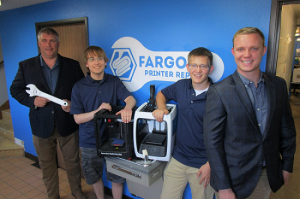 North Dakota-based Fargo 3D Printing has formed a new business out of its 3D printer repair segment, called Fargo 3D Printer Repair. While its parent company continues to focus on multiple aspects of the industry, the five-person repair team at the new Fargo 3D Printer Repair can devote 100% of its time to providing 3D printer repair and service to individuals, schools, OEMs, and businesses. The new spin-off company currently provides production-scale warranty servicing, maintenance, and repair services for multiple OEM 3D printing companies across North America; service and repair requests can be made through an intuitive form on its website.
North Dakota-based Fargo 3D Printing has formed a new business out of its 3D printer repair segment, called Fargo 3D Printer Repair. While its parent company continues to focus on multiple aspects of the industry, the five-person repair team at the new Fargo 3D Printer Repair can devote 100% of its time to providing 3D printer repair and service to individuals, schools, OEMs, and businesses. The new spin-off company currently provides production-scale warranty servicing, maintenance, and repair services for multiple OEM 3D printing companies across North America; service and repair requests can be made through an intuitive form on its website.
“We don’t sell any 3D printers ourselves, so we are able to remain brand impartial when recommending and performing 3D printer repairs,” said John Olhoft, the CEO of Fargo 3D Printer Repair, who started working in the original shop as a repair technician. “Original Equipment Manufacturers like that they can trust us to provide high quality repairs with a quick turnaround, and not push a competing brand on their customers.”
Sciaky Providing EBAM System to Metal 3D Printing Bureau
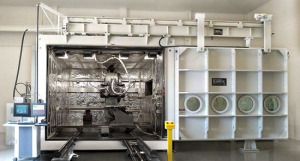 Metal 3D printing solutions provider Sciaky will provide one of its Electron Beam Additive Manufacturing (EBAM) systems to Michigan-based FAMAero (Future Additive Manufacturing in Aerospace), a privately-owned metal 3D printed parts bureau. According to Sciaky, this custom EBAM system will be the largest production metal 3D printer in the world, with a 146″ x 62″ 62″ nominal part envelope that will be able to produce metal parts over 12 feet in length. FAMAero will use the massive new EBAM system to provide metal 3D printing services to customers in the aerospace, defense, oil & gas, and sea exploration industries.
Metal 3D printing solutions provider Sciaky will provide one of its Electron Beam Additive Manufacturing (EBAM) systems to Michigan-based FAMAero (Future Additive Manufacturing in Aerospace), a privately-owned metal 3D printed parts bureau. According to Sciaky, this custom EBAM system will be the largest production metal 3D printer in the world, with a 146″ x 62″ 62″ nominal part envelope that will be able to produce metal parts over 12 feet in length. FAMAero will use the massive new EBAM system to provide metal 3D printing services to customers in the aerospace, defense, oil & gas, and sea exploration industries.
Don Doyle, President of FAMAero, said, “FAMAero is entering the market as the first private, dedicated parts bureau in North America for large-scale 3D printed metal parts. Our Factory as a Service concept, combined with Sciaky’s industry-leading EBAM® technology, will provide manufacturers a new avenue to significantly slash time and cost on the production of critical parts, while offering the largest build platform and selection of exotic metals to choose from in the 3D parts service market.”
Creating Customized Dental Solutions with 3D Systems’ SLA 3D Printing
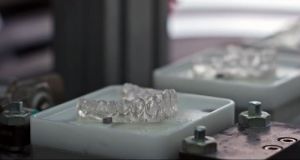 In order to make over 320,000 invisible dental aligners in a single day, Align Technology uses SLA 3D printing from 3D Systems. The company’s technology allows Align to create the unique aligner forms so that they are customized to each individual patient’s dental data. So far, Align has treated nearly 6 million patients, but using 3D printing technology is helping the growth of its business accelerate.
In order to make over 320,000 invisible dental aligners in a single day, Align Technology uses SLA 3D printing from 3D Systems. The company’s technology allows Align to create the unique aligner forms so that they are customized to each individual patient’s dental data. So far, Align has treated nearly 6 million patients, but using 3D printing technology is helping the growth of its business accelerate.
“What makes Align’s mass customization so unique is not only are we producing millions of parts every month, but each one of these parts that we produce is unique,” said Srini Kaza, the Vice President of Advanced Technology for Align Technology. “And this is really, as far as I know, the only true example of mass production using 3D printing.”
Ben Fearnley Uses SLA 3D Printing to Bring Artwork to Life
SLA 3D printing isn’t just good for use in dental applications, however. Ben Fearnley, a designer, illustrator, and 3D artist based out of New York City, uses the technology to, as he told 3DPrint.com, “bring my work to life from the 3D world to the real world.”
One interesting piece of 3D printed art Fearnley creates is Good Vibes Only Typography – script style typography lettering sculptures modeled in Cinema 4D and 3D printed on his Form 2. But my personal favorite are his Sculptmojis, which look pretty much exactly how they sound. These pieces, which are a combination of traditional sculpture art forms and modern emojis, originally began as a digital art project, and have now been brought to amusing, quirky life through 3D printing. You can purchase Fearnley’s unique 3D printed artwork here.
Discuss this research and other 3D printing topics at 3DPrintBoard.com or share your thoughts below.
Hobbyist 3D prints open source CNC machine for under $200
Inexpensive 3D Printed Membrane Feeder Aids in Malaria Studies
According to the Centers for Disease Control, in 2016 roughly 445,000 people around the world died of malaria, a serious disease caused by a parasite that often infects a certain type of mosquito, which in turn feeds on humans. 91% of these deaths were estimated to have taken place in the WHO African region, and most of these deaths were of young children, who are among the most vulnerable in areas of high transmission as they have not developed an immunity to the disease yet.
Malaria is one of the world’s most severe public health problems, and a lot of work has gone into using 3D printing to help diagnose and even cure the disease.
 A group of researchers from Imperial College London is studying how malaria is transmitted, which requires mosquito test subjects to be infected with Plasmodium gametocytes – the blood stage parasites that actually cause malaria. In a Standard Membrane Feeding Assay (SMFA) test, an artificial membrane feeding apparatus, which simulates the host’s skin and body temperature, is used to get the mosquitoes to eat reconstituted blood containing the gametocytes. These feeders warm infected blood using glass chambers or electric heating elements, both of which are hard to acquire and expensive to boot.
A group of researchers from Imperial College London is studying how malaria is transmitted, which requires mosquito test subjects to be infected with Plasmodium gametocytes – the blood stage parasites that actually cause malaria. In a Standard Membrane Feeding Assay (SMFA) test, an artificial membrane feeding apparatus, which simulates the host’s skin and body temperature, is used to get the mosquitoes to eat reconstituted blood containing the gametocytes. These feeders warm infected blood using glass chambers or electric heating elements, both of which are hard to acquire and expensive to boot.
The team recently published a paper, titled “An inexpensive open source 3D-printed membrane feeder for human malaria transmission studies,” that presents their creation and testing of an inexpensive, 3D printed membrane feeder.
“Presented here is a simple two-piece water-jacketed membrane feeder designed to hold a volume of 500 µl,” the paper reads. “Using the files presented here, the feeder can be 3D-printed directly and inexpensively by stereolithography by any equipped lab or commercial 3D-printing provider. Alternatively, by using a CAD package the size of the feeder can be up- or downscaled to hold more or less volume respectively.”
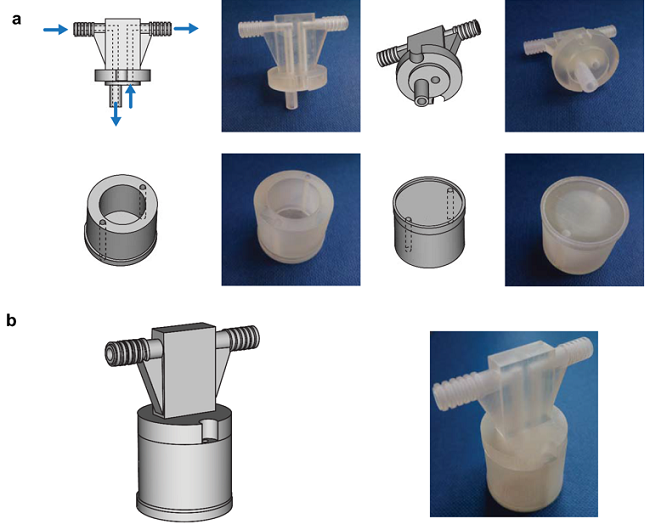
a) The membrane feeder was designed in two parts, a top chamber that connects to a circulating water bath and a bottom chamber holding a water reservoir and the RBC/gametocyte/serum sample on the underside. b) Both pieces are glued together into a single, watertight unit.
The researchers created the two-part membrane feeder design using the free, open source CAD modeling program Art of Illusion, then had Shapeways 3D print the parts out USP VI medical-grade “Fine Detail Plastic” acrylic resin (VisiJet M3 Crystal). Then, they conducted three independent SMFAs, using the Plasmodium falciparum laboratory strain NF54, in order to compare the performance of their 3D printed membrane feeder to that of a commercial glass feeder.
According to the study, “Exflagellation rates as well as oocyst counts indicate that there is no significant difference between the two, within the statistical power given by triplicate SMFAs used as standard by the research community.”
The researchers believe that by making the design files for their 3D printed membrane feeder open source, more laboratories will be able to perform these SMFAs, and can even customize the design if necessary.
“The 3D-printed feeder design enables researchers to inexpensively produce their own SMFA feeders as an alternative to expensive and fragile glass feeders that require specialist manufacturing,” the study concludes. “This new 3D-printed feeder can be used in a wide range of applications in addition to standard SMFAs, as it is not limited to the species used here. Application might include the assessment of vector competence for malaria, the epidemiological assessment of the infectious reservoir for malaria, clinical drug trials, and transmission-blocking studies.”
Co-authors of the paper include Kathrin Witmer, Ellie Sherrard-Smith, Ursula Straschil, Mark Tunnicliff, Jake Baum, and Michael Delves. The design files for the 3D printable membrane feeder can be found in the paper.
Discuss this story and other 3D printing topics at 3DPrintBoard.com or share your thoughts in the Facebook comments below.
Unpacking America’s downloadable 3D printed guns
Unique 3D Printed Connectors Help You Create Versatile Pieces of Furniture
While it is absolutely possible to 3D print custom furniture today, I think we can all agree that doing so is generally not as easy as just heading out to IKEA, Natuzzi or Ethan Allen or Value City Furniture or wherever it is you buy your home furnishings. In addition, some of the 3D printed furniture out there is just not that practical. Some pieces can even look like they belong on the set of another Willy Wonka movie remake…sorry if that’s harsh. But, that doesn’t mean we can’t use 3D printing to enhance or build furniture through the creative use of brackets, connectors, fasteners, and joints.
It’s entirely possible to improve upon furniture and make it your own without creating the entire piece in a wood or 3D printing workshop; most desktop 3D printers don’t have the build area to print a kitchen table anyway. But using connectors allows you to customize your furnishings without having to build something entirely new…unless you feel like it, of course.
Asa Christiana and Drew Prindle with Digital Trends recently highlighted a quick DIY end table project that used a 3D printed tripod joint.
“Before you do anything else, you should fabricate the 3D printed tripod joint,” Christiana and Prindle wrote. “This part is the keystone of the entire table, so it’s crucial that you get it right. By printing it first, you’ll be able to take it with you when you head out to buy materials, and make sure that all the dowels and screws you get will fit properly.”
The simple design for the 3D printable joint model, by Cults3D user Alejandro Macias, will need to be tweaked so you’re sure the three 7/8″ dowel rods used as the table legs will fit. Once the file has been downloaded and loaded into a slicer program, you’ll want to scale the part’s flange up to about 106% of its original size, or even 107% just to be safe. Print the part on a 3D printer with a build envelope of at least 105 mm wide and 130 mm tall.
“After printing a few of these suckers, we determined that you need to bump up the number of shells (the outer layers of the print) and the amount of infill (the interior of the print) considerably in order to give the completed part more structural integrity,” Christiana and Prindle explained. “We printed ours with six shells and 40 percent infill, but you might want to kick it up even more (say, 8 shells and 50 percent infill) if you plan on putting heavier items on the table.”
They also noted that the interior will need to have supports, as there is a possible failure-causing “unsupported stalactite in the middle of the model.”
The dowel rods should slide right into the 3D printed joint, which includes small screw holes in the sides for fixing everything into place; these holes will probably need to drilled a little bit larger so the screws can freely pass through.
“To make sure you don’t create the Leaning Table of Pisa, draw a light pencil line about 1.5 inches from the end of each leg before inserting it, to help you insert them all the same amount,” said Christiana and Prindle. “Once you do, use the screw holes in the flange to locate and drill small pilot holes in the sides of the dowels before driving the screws. There isn’t much danger of the screws cracking the tabletop, but they could split the dowels if you don’t drill pilot holes.”
To learn all the important details of building the actual table, check out the rest of the project here.
Over the last few years, we’ve seen all kinds of interesting 3D printed furniture connecting pieces. For example, the Control DIY Furniture collection by Jack Holloway offers open source, downloadable files of custom, 3D printable furniture joints that, once completed, can be fitted with standard dimension lumber to build benches, tables, and chairs. These joints are recommended to be printed in nylon (polyamide), acrylics, and even metal. These look so elegant, you’d think the entire piece was built to look that way.
3D printed connectors offer versatility, letting you create unique pieces of furniture that sit at unusual angles, link together, or even create a table out of four chairs and a flat surface – perfect for smaller spaces. Italian-Japanese Studio Minale-Maeda created 3D printable sculptural Keystone connectors, which can be ordered from the Rotterdam studio or, to help cut down on emissions resulting from shipping and the need for big-box stores, be 3D printed as an open source design. These connectors can be tightened easily with a screwdriver, to help you repurpose old furniture parts or assorted pieces of wood into new furnishings.
The Playwood collection of colorful 3D printed connectors by Italian designer Stefano Guerrieri gives you the flexibility to change up your environment on a whim, with only an Allen key needed to tighten the connections. Build your own furniture with whatever materials you want – so long as they are between 1.5 and 2 cm thick – and join the pieces together at 90°, 105°, or 150°, with three different kinds of recyclable polyamide connectors. According to the designer, Playwood was inspired as a modular and tactile response to the creativity-killing environment of a static office.
“We believe that people should be able to shape their own places according to what they do, we believe in modularity and creativity freedom,” said Guerrieri. “It doesn’t matter if it is a freelance studio or a billion dollar corporate office, the ability to organize your space is a powerful tool that brings office relationships to the next level and fosters innovation.”
Personally, I prefer my furniture to be a little less whimsical than the Playwood collection, but to each his own…which is the whole point of custom 3D printable furniture connectors, of course.
Discuss 3D printed furniture connectors and other 3D printing topics at 3DPrintBoard.com or share your thoughts in the Facebook comments below.
3D Printing Community saddened by closure of Printrbot 3D printers
U.S. Government lifts ban on Cody Wilson’s 3D printed guns, Senvol joins armaments consortium
3Dsimo Kit is an Open Source, Multimaterial 3D Pen Assembly Kit
 3Dsimo Kit is the world’s first multimaterial assembly kit 3D pen. Based on the same idea as RepRap 3D printers, every part of 3Dsimo Kit is open source. All the necessary blueprints are freely available on our website, 3dsimo.com, or on GitHub at github.com/3dsimo/3dsimo_kit. This assembly kit is easy to assemble — the whole build includes only 2 bolts, everything else is snapped or plug-in. Assembly takes 15-20 minutes. Thanks to the OLED display, choosing material profiles is quick and easy. 3Dsimo Kit is set up from the package with profiles for ABS and PLA filament. Adding new material profiles is very easy, all the needed manuals are available at: https://github.com/3dsimo/3dsimo_kit. Every week there will be new upgrades, software or hardware, which will be ready to be 3D printed or uploaded to the device.
3Dsimo Kit is the world’s first multimaterial assembly kit 3D pen. Based on the same idea as RepRap 3D printers, every part of 3Dsimo Kit is open source. All the necessary blueprints are freely available on our website, 3dsimo.com, or on GitHub at github.com/3dsimo/3dsimo_kit. This assembly kit is easy to assemble — the whole build includes only 2 bolts, everything else is snapped or plug-in. Assembly takes 15-20 minutes. Thanks to the OLED display, choosing material profiles is quick and easy. 3Dsimo Kit is set up from the package with profiles for ABS and PLA filament. Adding new material profiles is very easy, all the needed manuals are available at: https://github.com/3dsimo/3dsimo_kit. Every week there will be new upgrades, software or hardware, which will be ready to be 3D printed or uploaded to the device.
3Dsimo Inc. produces more than just the 3Dsimo Kit:
3Dsimo Basic – 3D pen designed for kids of 8+ years of age, using PCL filament, with nozzle that keeps the temperature low (55°C/131°F) to avoid burn injury. The whole device is powered from a detachable battery.
3Dsimo Mini – our best multitool 3D pen, which offers not just 3D drawing with more than 4 material profiles, but burning tool (for decorating wood, leather or smoothing 3D printed objects), soldering tool (for small electronic repairs and creations), and cutting tool (for cutting plastic foam, polystyrene, etc.). 3Dsimo Mini also offers bluetooth connectivity via app with Android or Apple devices, for even more functionality. Using 3Dsimo App you can update your firmware to be able to use new attachments, create new material profiles, watch tutorials, print out templates or be inspired by gallery full of creations.
More information about 3Dsimo devices is available on the website: www.3dsimo.com.
Discuss this and other 3D printing topics at 3DPrintBoard.com or share your thoughts below.

